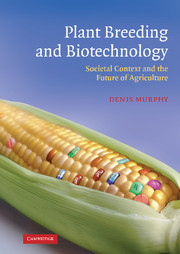Book contents
- Frontmatter
- Contents
- Preface
- Acknowledgements
- Using this book
- Nomenclature and terminology
- Abbreviations and glossary
- Introduction
- Part I The science of plant breeding
- Part II The societal context of plant breeding
- Part III Turmoil and transition: the legacy of the 1980s
- Part IV The agbiotech paradigm
- Part V Increasing global crop production: the new challenges
- Part VI Plant breeding in the twenty-first century
- 16 The future of international plant breeding
- 17 Rebalancing our approach to crop improvement
- 18 Where do we go from here?
- 19 Conclusions and recommendations
- Notes
- References
- Index
19 - Conclusions and recommendations
Published online by Cambridge University Press: 07 May 2010
- Frontmatter
- Contents
- Preface
- Acknowledgements
- Using this book
- Nomenclature and terminology
- Abbreviations and glossary
- Introduction
- Part I The science of plant breeding
- Part II The societal context of plant breeding
- Part III Turmoil and transition: the legacy of the 1980s
- Part IV The agbiotech paradigm
- Part V Increasing global crop production: the new challenges
- Part VI Plant breeding in the twenty-first century
- 16 The future of international plant breeding
- 17 Rebalancing our approach to crop improvement
- 18 Where do we go from here?
- 19 Conclusions and recommendations
- Notes
- References
- Index
Summary
No, a thousand times no; there does not exist a category of science to which one can give the name applied science. There are science and the applications of science, bound together as the fruit to the tree which bears it.
Louis Pasteur (1871) Revue ScientifiqueIntroduction
In this book, we have surveyed the evolution of modern plant breeding, and its application in crop improvement, over the past two centuries. We have examined crop improvement from a variety of scientific and socio-economic perspectives and have seen the sometimes surprising ways in which these interact to affect the trajectory of agriculture. Overall, there is no doubt that scientific plant breeding has been an outstanding success, enabling farmers to feed the more than seven-fold increase in the global human population that has occurred since 1800. But we have also seen that all is not well with plant breeding, especially in the public sector. Over recent years, researchers and some science policymakers have started to realise what breeders had been aware of since the early 1990s, namely that plant breeding is sliding ever more deeply into crisis. One of the key aims of this book has been to highlight such concerns, to explain their provenance, and to lay out some of the options that might allow us to surmount these challenges in the years to come.
In this final chapter, we will first consider some emerging ideas from the USA that were published after much of the present book had been written.
- Type
- Chapter
- Information
- Plant Breeding and BiotechnologySocietal Context and the Future of Agriculture, pp. 294 - 302Publisher: Cambridge University PressPrint publication year: 2007



